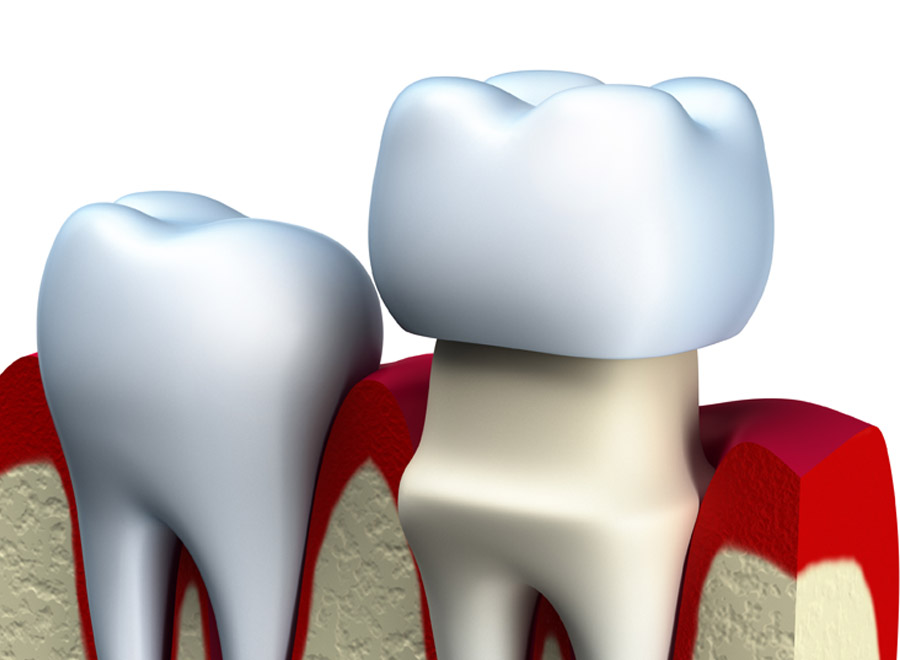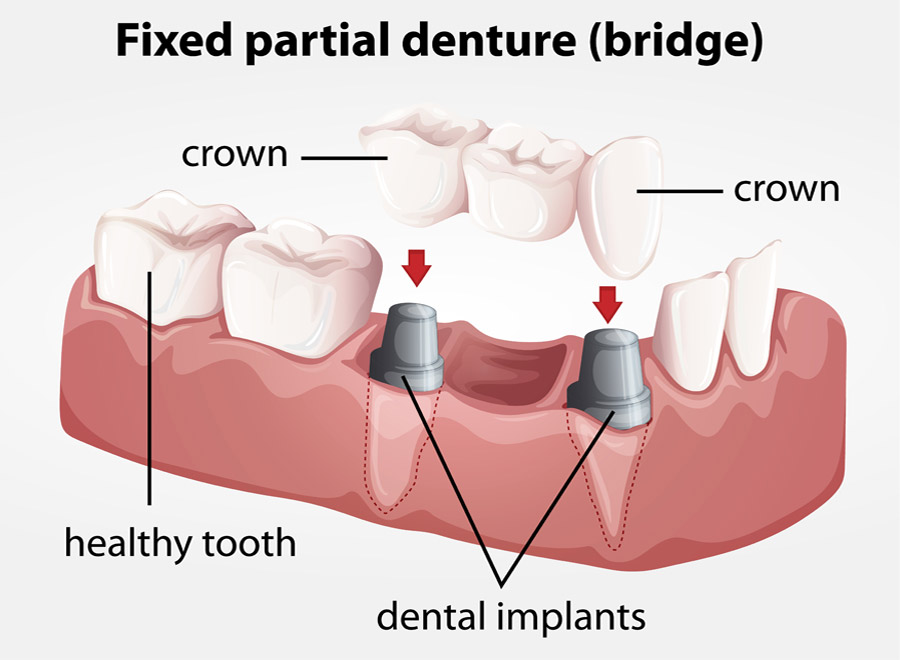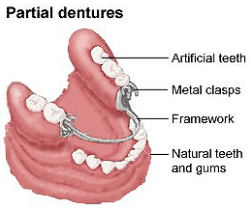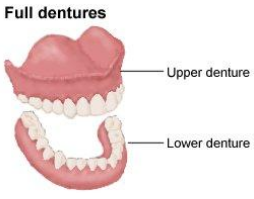Prosthetics for teeth
The loss of teeth can lead to distortion of facial features and impair proper function. With the lack of structural support, the remaining teeth tend to bend and misalign – failing to provide support for the soft facial tissues (cheeks and lips). This, in turn, causes structural changes in the face, where the cheeks ‘fall’ due to lack of support and create deep furrows between the nose and corners of the mouth – giving it an aged appearance.
To prevent this, the loss of teeth has to be compensated for, by using various prosthetic devices and appliances – which can be fixed (dental bridges, implants, crowns) or removable (partial or total dentures).
Fixed Prosthetic Appliances
Dental Crowns

Sometimes, despite your best efforts, teeth are damaged through injury or decay. When this happens, our goal is to act quickly in order to restore the health of the affected tooth and the appearance of your smile. If the damage is minimal, a simple filling or tooth bonding may suffice.
A dental crown replaces the natural crown of the tooth in the cases where it has been damaged, fractured, malformed, discolored – or has to be rebuilt following a root canal treatment. It is crafted based off an imprint of your jaw, to fit perfectly with the natural dentition and presents a long-term solution that is both functional and aesthetic. Not only will they improve the function of your teeth, but they also look incredibly realistic.
What does dental crown treatment involve?
The dental crown is going be made to address your specific need (shape, size), using the latest techniques and the highest quality materials. Each of our crowns is handcrafted to provide a natural appearance and lasting results.
A dental crown can be made from metal, porcelain fussed on metal or just porcelain – zirconium.
Usually, the treatment requires two appointments. During your first appointment, we’ll remove any decay before reshaping(reducing) the affected tooth – to prepare to fit the new dental crown. We’ll then take an impression of your teeth so our technicians can craft a crown which is an exact replica of your natural tooth. In the meantime, we’ll fit a temporary acrylic crown, so you won’t be left with a gap between treatments.
At your second appointment, the new crown will be ready for placement. We are going to make certain that you are satisfied with the look of your crown before cementing it into place.
Metal dental crown
Metal crowns are very resistant, the most economical, but lack in the way of aesthetics. They are usually used on out-of-sight molars. Since the metal crowns are often made of nickel/chromium alloy, they are not recommended for patients who are allergic to nickel. This type of dental crowns has fallen out of favor as there are far more suitable options available.
Porcelain-fused-to-metal (PFM) crowns
Porcelain-fused-to-metal (PFM) crowns have a metal structure which is fully covered with porcelain. That makes them as strong as metal crowns while providing a perfect aesthetic solution at the same time. Thus, the PFM crowns can be used to replace posterior as well as anterior teeth.
All-porcelain or All-ceramic (Zirconium) Crowns
All-porcelain crowns are made entirely of porcelain and have a porcelain or zirconium structure. Currently, zirconium oxide is the most advanced material for the production of dental crowns. Its peerless strength, as well as aesthetic properties, are orders of magnitude apart from ceramic crowns. They provide better insulation and less irritation to the treated tooth and surrounding (periodontal) tissues. Their hypoallergenic property makes them the preferred material of choice for sensitive patients.
Dental Bridges

A missing tooth can cause a lot of stress! Large gaps between your teeth not only look unsightly but can alter your bite, increase strain on the surrounding teeth and cause gum disease or decay. Dental bridges are fixed partial dentures designed to fill the edentulous gap in the jaw and restore the functionality and aesthetics of your tooth(or teeth).
Thanks to technological advances in dentistry, beside porcelain-fused-to-metal (PFM) bridges, porcelain bridges are now available and able to completely imitate your natural teeth, blending perfectly and restoring your natural smile.
How do dental bridges work?
Bridges replace one or more missing teeth and consist of two crowns (one on each surrounding tooth) between which the false tooth is anchored. If there’s more than one tooth missing, the bridge may consist of several false teeth joined together. For this to work, however, the ‘carrier’ teeth have to be in good health.
Bridges are custom-made in our laboratory and can consist of porcelain fused to precious metal or porcelain alone. Each option has its own advantages and disadvantages, so we are always going to consult with you in order to determine your viability for your chosen type of dental bridge.
How are dental bridges placed?
Typically, dental bridges are placed during two appointments.
During the first appointment, the area is anesthetized and the adjacent teeth are reduced(trimmed down) slightly to accommodate their crown. Then, a mould of your entire jaw is taken, which serves as a basis used to create the dental bridge in our laboratory. At this point, we’ll also determine the right hue for your bridge. Finally, we’ll fit a temporary bridge until the permanent bridge is ready.
During the second appointment, we will remove the temporary bridge and fit the new one. Once we establish that the permanent bridge fits well and delivers a good bite, we’ll cement into place – restoring your smile and self-confidence.
Mobile Prosthetic Appliances
Mobile prosthetic appliances are those which can be removed from the patient’s mouth. With the use of sophisticated instrumentation, all of your facial information is recorded. After impressions of your jaw and bite. The dentures can restore your smile and the natural contour of your facial features. Generally, they can be put into two groups: partial dentures and full dentures.
Partial Dentures
 Partial plate dentures are used to compensate for one or more missing teeth in a jaw that still contains natural teeth. They have a life-cycle of about ten years.
Partial plate dentures are used to compensate for one or more missing teeth in a jaw that still contains natural teeth. They have a life-cycle of about ten years.
Modern-day dentures can be crafted to replicate your natural teeth and are much more comfortable than they used to be. Over time they might require refitting as the shape of the jaw changes with age.
Full Dentures
 In cases where the entire jaw is edentulous, full dentures can be used to compensate for the missing teeth.
In cases where the entire jaw is edentulous, full dentures can be used to compensate for the missing teeth.
Generally, they are made from acrylic polymer and can be reinforced with a metal grid. For patients who are allergic to acrylic, crystal prostheses are used instead.
The dentures procedure
The procedure is usually non-invasive and requires three appointments. During the initial appointment, the dental specialist will perform a thorough examination of your current condition to check your viability for dentures. Any oral health problems have to be treated before the dentures can be applied (tooth decay, gum disease etc.).
During the second appointment, a mould is taken from your jaws, to serve as a basis to craft your dentures. When your new dentures are ready, we’ll make sure they’re a good fit and your smile is restored!
Frequently Asked Questions about Dental Prosthetics
Crowns / Bridges
Thanks to technological advances in dentistry, all porcelain crowns/bridges can perfectly emulate natural teeth in both function and aesthetics.
Dental crowns/bridges can last up to 15 years with adequate oral hygiene.
The success rate of dental crowns and bridges is extremely high (>98%). During the initial meeting, the dental specialist will assess your current oral condition and viability for treatment. He/she will also consult with you about any preferences or concerns you might have.
Dentures
Removable complete denture: A completely edentulous jaw can be fitted with an acrylic resin denture, which has to fit perfectly to the gum line.
Removable partial denture: It is a rigid denture with a metal base, supported by the gum line alongside the remaining teeth with metal clasps and framework. Because it is supported by natural teeth, this type of denture is more stable than the complete denture.
Removable denture on implants: This is the most stable type of denture because it is supported by dental implants which have to be previously surgically inserted into the jaw bone. Approximately, 3 months after the placement of the implants, the denture is attached to them and surrounding gum line.
The material used to make denture teeth is usually acrylic polymer supported by a metal (or porcelain framework in the case of partial dentures. Usually, denture teeth are slightly more fragile and can chip and crack without adequate care.
The main benefit of using dentures to replace missing teeth is that they are a cheaper alternative to dental bridges and dental implants. They have the following benefits too:
- Dentures improve your appearance and therefore your confidence
- They prevent your existing, healthy teeth from moving
- They make chewing and talking easier
- They usually require no surgery or invasive procedures.
These dentures are created to immediately replace the extracted teeth during the denture treatment. These dentures can be more easily refitted than permanent dentures to accommodate for mouth changes while healing. These immediate dentures will be disposed of once the healing process is complete, and your mouth is ready for the permanent dentures.
Over-dentures are an alternative that can be used if traditional dentures prove to be extremely uncomfortable. Over-dentures are fitted over the roots of natural teeth, or on dental implants. Some patients find this type of dentures more comfortable and more easily removable.
Rinse your dentures before brushing to remove any food or debris.
Use a soft bristle toothbrush and a non-abrasive cleanser to gently brush the entire surface area of the dentures.
When brushing, clean your mouth thoroughly—including your gums, the inside of your cheeks, roof of your mouth and tongue, to remove any plaque. This can help reduce the risk of oral irritation and bad breath.
When you’re not wearing your dentures, put them in a safe place covered in water to prevent them from warping.
Occasionally, some denture wearers may use adhesives. Adhesives come in many forms: creams, powders, pads/wafers, strips or liquids. If you use some of these products, read the instructions, and use them exactly as directed. Your dentist can recommend appropriate cleansers and adhesives to take proper care of your dentures.

